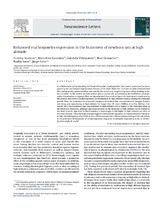Enhanced erythropoietin expression in the brainstem of newborn rats at high altitude
Fecha
2011Autor
Seaborn, Tommy
Gonzales, Marcelino
Villalpando, Gabriela
Grenacher, Beat
Soria, Rudy
Soliz, Jorge
Metadatos
Mostrar el registro completo del ítemResumen
Abstract.
In addition to its role in elevating red blood cell number, erythropoietin (Epo) exerts protective functions
against acute and delayed degenerative diseases of the brain. Moreover, we have recently demonstrated
that endogenously synthesized Epo and soluble Epo receptor (a negative regulator of Epo binding to the
Epo receptor) in the central nervous system play a crucial role in facilitating the ventilatory response
and acclimatization to hypoxia. Here we hypothesized that cerebral Epo in the brainstem is implicated in
the process that allows cardiorespiratory acclimatization to high altitude hypoxia during the postnatal
period. Thus, we evaluated the postnatal ontogeny of cerebral Epo concentration of Sprague-Dawley
rats living and reproducing at high altitude for longer than 19 years (3600 m in La Paz, Bolivia). Our
results show that postnatal Epo concentration in high-altitude rats is higher in the brainstem than in
the forebrain. Moreover, although Epo concentration in the forebrain of high-altitude rats is similar to
sea-level controls, Epo level in the brainstem is surprisingly 2-fold higher in high-altitude rats than in
sea-level controls. These findings strongly suggest that brainstem Epo plays an important role in tolerance
to high altitude hypoxia after birth. From a clinical perspective, a better understanding of the role of Epo
in the postnatal development of cardiorespiratory responses in neonates exposed to acute or chronic
hypoxia might be useful.

